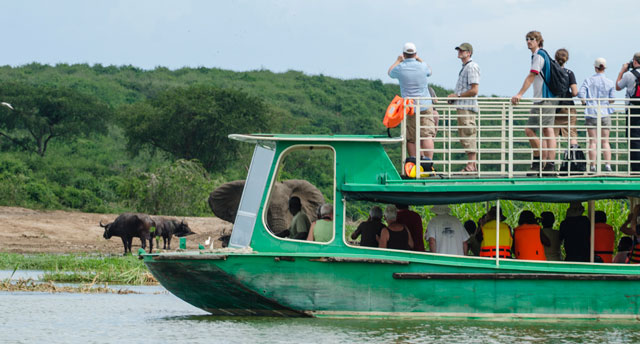Animals disappearing from Queen Elizabeth National Park
A number of players in the tourism sector say Queen Elizabeth National Park known for its wildlife may lose its international appeal because tourists can hardly see the animals.
The animals according to the tour operators seem to be "disappearing" from the tracks where they could easily be seen by tourists.
Queen Elizabeth National Park is known for its wildlife. It is home to 95 species of mammal and over 500 species of birds including Cape buffaloes, hippopotami, crocodiles, elephants, leopards, Congo lions, and chimpanzees.
But Geoffrey Baluku, who grew up in Kasese near this park and has since become a tour operator in Queen Elizabeth National Park is sounding an alarm bell saying the animals have disappearing in what appears like mass migration.
The problem, according to Baluku is that park authorities are taking too long to find a lasting solution to the invasive plant species that are rapidly expanding in the park affecting grazing areas of the wildlife.
The invasive plant species have according to Baluku affected the habitats of some of the animals have moved away from the known game tracks. He says tour operators are now prefer taking their visitors on launch cruise instead of game drive.
Robert Baluku, Acting Principal Uganda Wildlife Research and Training Institute is concerned about the spread of invasive species.
We have seen a document suggesting the need to uproot over 33 hectares of lantana camara in Queen Elizabeth national Park.
Parthenium hysterophorus species of flowering invasive plant that is rapidly spreading through the park.
It is threatening biodiversity, human and livestock health and wildlife in Queen Elizabeth. The congress weed is said to be covering 10 square kilometers of Queen Elizabeth National Park. It spreads to part of Mweya Peninsular.
The International Union for Conservation of Nature (IUCN) in 2010 warned that if left unchecked, the congress weed could threaten the continued migration of millions of animals across the plains every year.
Queen Elizabeth National Park also has another invasive spear grass and Dichrostachys cinerea also affecting the wildlife habitats.Uganda Wildlife rangers have in the past resorted to burning the elephant grass as a control measure. Some experts have warned against burning of the spear grass saying the fire kills slow-moving animals like snakes and others species.
Robert Baluku has witnesses the burning of the park especially as helpless rangers try to control spear grass.
The migration of the wildlife close to community areas according to Baluku comes with the danger of fueling conflict between communities and wildlife.
Andrew Sseguya, Executive Director Uganda Wildlife Authority acknowledged the fact that invasive plants species were spreading but denied that animals have disappeared from Queen Elizabeth National Park.
He said in 2010 the population of elephants was 2500.
He said the population of buffalos has equally increased from 8200 in 2010 to over 15, 770.
The Uganda Wildlife Conservation Society which has been in conservation efforts for over 50 years said invasions by introduced species are the third biggest threat to biodiversity in Uganda today after habitat loss and unsustainable utilization of natural resources.
Geoffrey Mwedde, the Regional Manager at Wildlife Conservation Society said there is a danger that the invasive species in Queen Elizabeth National Park will transform its ecosystem structure and functioning.
Sseguya said Uganda Wildlife Authority in collaboration with National Agricultural Research Organization (NARO) will carry out research on how to deal with invasive plant species.
He insisted that Queen Elizabeth is the most visited national park.













